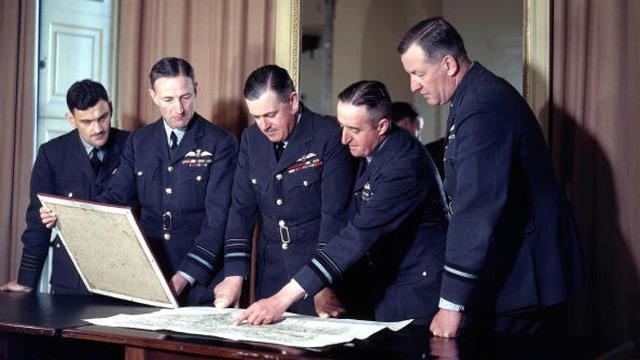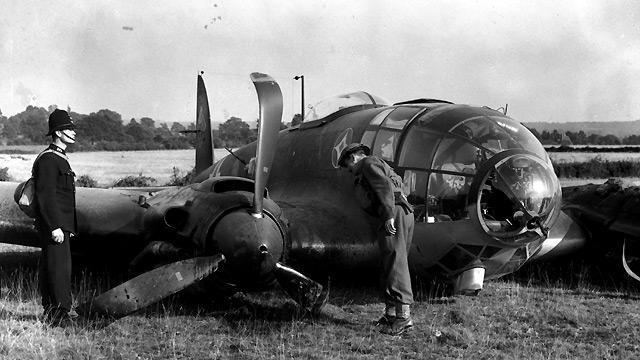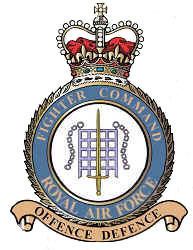Active 14 July 1936–1968 Motto Offence Defence | Country United Kingdom Founded 14 July 1936 | |
 | ||
Fighters Notable commanders Hugh Dowding, Sholto Douglas, 1st Baron Douglas of Kirtleside Similar RAF Bomber Command, RAF Coastal Command, RAF Transport Command, Royal Air Force, Allied Air Forces Central E | ||
6 gladiators of ww2 raf fighter command
RAF Fighter Command was one of the commands of the Royal Air Force. It was formed in 1936 to allow more specialised control of fighter aircraft. It served throughout the Second World War. It earned great fame during the Battle of Britain in 1940, when the Few held off the Luftwaffe attack on Britain. The Command continued until 17 November 1943, when it was disbanded and the RAF fighter force was split into two categories; defence and attack. The defensive force became Air Defence of Great Britain (ADGB) and the offensive force became the RAF Second Tactical Air Force. Air Defence of Great Britain was later renamed Fighter Command. It was finally disbanded in 1968.
Contents
- 6 gladiators of ww2 raf fighter command
- Woman veteran of raf fighter command on bbc news
- Origins
- Battle of Britain
- 1941 air offensive
- 194245
- Royal Observer Corps
- Cold War years
- Strike Command
- References

Woman veteran of raf fighter command on bbc news
Origins

On 20 May 1926, Fighter Command's precursor organisation was established as a group within Inland Area. On 1 June 1926, Fighting Area (as it was then called) was transferred to the Air Defence of Great Britain. Fighting Area was raised to Command status in 1932 and renamed Fighter Command on 1 May 1936.
Battle of Britain

Over the next few years, the Command expanded greatly and replaced its obsolete biplane squadrons with two of the most famous aircraft ever to fly with the RAF, the Hawker Hurricane and the Supermarine Spitfire. The supreme test of Fighter Command came during the summer of 1940 when the German Luftwaffe launched an offensive aimed at attaining air superiority over the Channel and the UK as a prerequisite to the launch of a seaborne invasion force (codenamed Operation Sea Lion). Fighter Command was divided into a number of Groups, each controlling a different part of the UK. 11 Group took the brunt of the German attack, as it controlled southeast England and London. It was reinforced by 10 Group, which covered southwest England, 12 Group, which covered the Midlands and East Anglia and 13 Group which covered the North of England and Scotland. In the end, the Germans failed to attain air superiority, although the RAF had been eating into its reserves during the battle, as had the Luftwaffe.
1941 air offensive

As 1941 began, Fighter Command began the onerous task of winning air superiority over North Western France from the Germans. By May 1941, the Squadrons based at all the main fighter airfields were now to operate together as integral Fighter Wings, under the tactical control of the newly created post of 'Wing Leader', invariably an experienced 1940 veteran of wing commander rank. Various types of short-penetration fighter operations were tried out in a bid to draw the Luftwaffe into a war of attrition, and keep inordinate numbers of fighters tied down in France, particularly after the German attack on the Soviet Union in June 1941. Large numbers of Spitfires were sent out with small groups of medium bombers in often vain attempts to lure the German fighters into combat. Results of these operations through 1941 were decidedly mixed, as the short range of the Spitfire precluded an overly aggressive stance, and with just two experienced Jagdgeschwader units left in Western Europe (JG 2 & JG 26; comprising 180 fighters at most) targets were often few but dangerous. Most of the factors that had allowed Fighter Command to win the Battle of Britain were now reversed. For example, British pilots who were shot down in 1940 and survived would be patched up and sent back to their units as quickly as possible. In 1941, over France, a shot down pilot would, as likely as not, end up a prisoner of war. The year saw RAF Fighter Command claim some 711 Luftwaffe fighters shot down (although only 236 were lost from all causes, 103 in combat) for losses of approximately 400 RAF fighters lost. As 1941 ended, the appearance of the new Fw 190, with its obvious technical superiority over the current Spitfire Mark V, would make Fighter Command's job that much harder in 1942.

Parallel to the day offensive in 1941 was the ongoing night bomber attacks against the United Kingdom in January to May. By this time, until May 1941, the Luftwaffe effort was aimed against both civilian and industrial targets. Fighter Command's defences, however improved almost daily during the first six months of 1941. The Bristol Beaufighter became the prime nightfighter, equipped with airborne radar, it proved ever more effective against the bombers, with the ground-based organisation that proved so efficient in 1940 now guiding the night fighters to their targets. An increasing number of anti-aircraft guns and searchlights were also radar-controlled, improving accuracy. From the start of 1941, the Luftwaffe's losses mounted (from 28 in January to 124 in May). With the impending invasion of Russia requiring the movement of air power to the East, the Blitz ended in May 1941 with Fighter Command in complete control of the night sky over the UK.
1942–45
The difficult task of slowly grinding down the Germans continued into 1942 and 1943. Squadrons also found themselves on tiring defensive patrols as small formations of FW-190s started to fly 'hit and run' nuisance raids all along the South Coast. Fighter Command deployed their new Hawker Typhoon units at this time. The most notable offensive battle took place over Dieppe, France when an ill-fated commando-style raid was mounted there in August 1942 (Dieppe Raid). The Luftwaffe and RAF clashed in the skies over the French city. Although the RAF succeeded in preventing the Luftwaffe from interfering with the shipping, which was its primary aim, its perceived success was misleading. Despite claims at the time that more German aircraft than British had been shot down (106 kills were claimed by the RAF) postwar analysis showed Allied aircraft losses amounted to 106, including 88 RAF fighters and 18 bombers. Of the fighter losses 29 were from flak, one ran out of fuel, two collided, and one was a victim of friendly fire. Against this, 48 Luftwaffe aircraft were lost. Included in that total were 28 bombers, half of them Dornier Do 217s from KG 2. One of the two Jagdgeschwader's, JG 2, lost 14 Fw 190s and eight pilots killed. JG 26 lost six Fw 190s with their pilots. Spitfire losses stood at 70 destroyed and damaged to all causes. The Spitfire squadrons (42 with Mark Vs, and four with Mark IXs) were tasked with ground-attack, escort and air-superiority missions, so the exact number of Spitfire losses to the Fw 190 is unknown. The Luftwaffe claimed 61 of the 106 RAF machines lost, which included all types (JG 2 claimed 40 and JG 26 claimed 21 kills).
1942 statistics yielded 560 claims (272 German fighters were lost from all causes) for 574 RAF day fighters destroyed.
By the autumn of 1942, the arrival of the USAAF 8th Air Force and its daylight bombers would add bomber escort to Fighter Command's tasks. Until American Republic P-47 Thunderbolt fighter groups were operational in May 1943, the Command's Spitfires performed a vital role in protecting the increasing numbers of Boeing B-17 Flying Fortresses and Consolidated B-24 Liberators operating over Occupied Europe. The Spitfire's chronic lack of operational range however meant such protection was limited to the Channel and the European coast.
In 1943, the most notable event was a very important administrative one. Fighter Command was split up into the Air Defence of Great Britain and the Second Tactical Air Force. As the name of the former suggests, its primary aim was defence of the UK from attack, with the latter concentrating on supporting ground forces after the eventual invasion of Europe.
1944 saw the greatest effort by the Air Defence of Great Britain in its history. Operation Overlord, the invasion of France was launched on 6 June 1944. RAF fighters swarmed over the battle area and, along with their American counterparts, suppressed the meagre German opposition. They also directly supported ground forces by strafing enemy positions and transport. Later in the year, the final major test of Fighter Command (renamed back in October 1944) in the war occurred against the V-1 flying bomb during Operation Crossbow. RAF fighters also supported the strategic bombing of Operation Crossbow, such as with long-range intruder operations that attacked German airfields and aircraft (e.g., at take-off/landing) at the time the Luftwaffe fighters would be scrambled against RAF Bomber Command (see Operation Hydra).
During 1939–45, RAF Fighter Command lost 3,690 killed, 1,215 wounded and 601 POW. 4,790 aircraft were lost.
Royal Observer Corps
As a direct result of their efforts during the Battle of Britain the Observer Corps was granted the title Royal by King George VI and became a uniformed volunteer branch of the RAF from April 1941 for the remainder of its existence, retitled the Royal Observer Corps (ROC). The corps would continue as a civilian organisation but wearing a Royal Air Force uniform and administered by Fighter Command.
With their Headquarters at RAF Bentley Priory the ROC remained administered by Fighter Command until 31 March 1968 when responsibility was handed over to the newly formed RAF Strike Command.
The ROC was a defence warning organisation operating in the United Kingdom between 1925 and 31 December 1995 when it was stood down. Initially established for an aircraft recognition and reporting role that lasted through both world wars, the organisation switched to a Cold War nuclear reporting role during the 1950s. The 10,500 ROC volunteers were trained and administered by a small cadre of sixty nine uniformed full-time professional officers under the command of a serving RAF Air Commodore.
Cold War years
In the aftermath of World War II, the role of Fighter Command was still to protect the UK from air attack. However, its target changed from Germany to the Soviet Union. The Cold War saw the threat of Soviet bombers attacking the United Kingdom loom large. A Canadian fighter wing, No. 1 Wing, arrived at RAF North Luffenham in late 1951 to bolster NATO's strength, and was in a position to assist Fighter Command until it relocated to bases in France and West Germany in 1954-55. After 1949, those Soviet bombers could be carrying nuclear weapons, and so intercepting them was crucial if the United Kingdom was to be saved during a war. A long succession of fighter aircraft saw service with Fighter Command during the 1950s and 1960s. Particularly notable types were the Gloster Meteor, Hawker Hunter, Gloster Javelin and the English Electric Lightning.
The Lightning was the only purely British supersonic aircraft to enter service. That was due to a disastrous defence review in 1957. During the mid-1950s, the performance of the new surface to air missiles was improving at an enormous rate. Duncan Sandys, the Minister of Defence at the time needed to find cuts in the British defence budget, since the UK was in serious danger of being bankrupted by its defence spending. The rate of improvement of surface to air missiles seemed to indicate that they would soon be able to shoot any manned aircraft out of the sky. Consequently, in an infamous statement in the 1957 Defence White Paper the Sandys review declared that manned aircraft were obsolescent and would soon become obsolete. All programmes for manned aircraft that were not too far along were cancelled. The Lightning was the only one of a number of new supersonic aircraft that was too far along to cancel. That decision, combined with the increasing costs of developing aircraft crippled the British aircraft industry and made Fighter Command and the RAF reliant on foreign or jointly developed aircraft.
In 1961, RAF Fighter Command was assigned to NATO's air defence system. On 1 May, Air Officer Commanding in Chief, Fighter Command, Air Marshal Sir Hector McGregor assumed the additional title of Commander United Kingdom Air Defence Region. The ADR itself stretched some hundreds of miles to the north, west and south of the country and almost to the continental coastline in the east.
Strike Command
As the 1960s dawned, the RAF continued to shrink. The three functional commands, Fighter Command, Bomber Command, and Coastal Command had all been formed in 1936 to help command an expanding RAF. It was now becoming clear that the RAF was simply becoming too small to justify their continued existence as separate entities. Consequently, in 1968, Fighter Command and Bomber Command were joined together to form Strike Command, each becoming groups within the new command.
